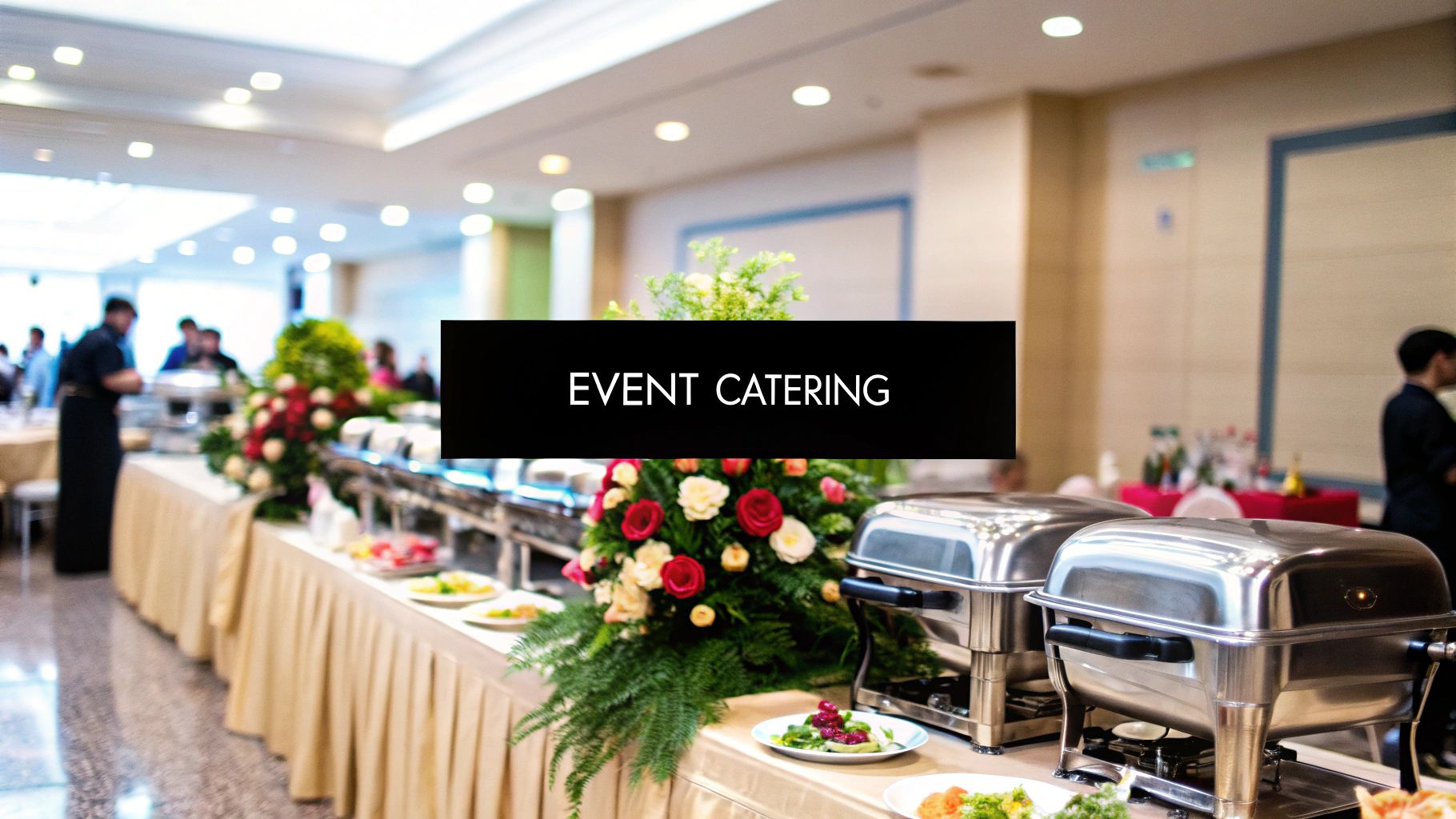Great event catering doesn't just happen on the day of. The real magic begins much earlier, with a solid plan that maps out your headcount, budget, and the overall feel of the event. Nailing these fundamentals is the secret to making sure the food, service, and atmosphere all come together to create an experience everyone will remember.
Building Your Catering Foundation
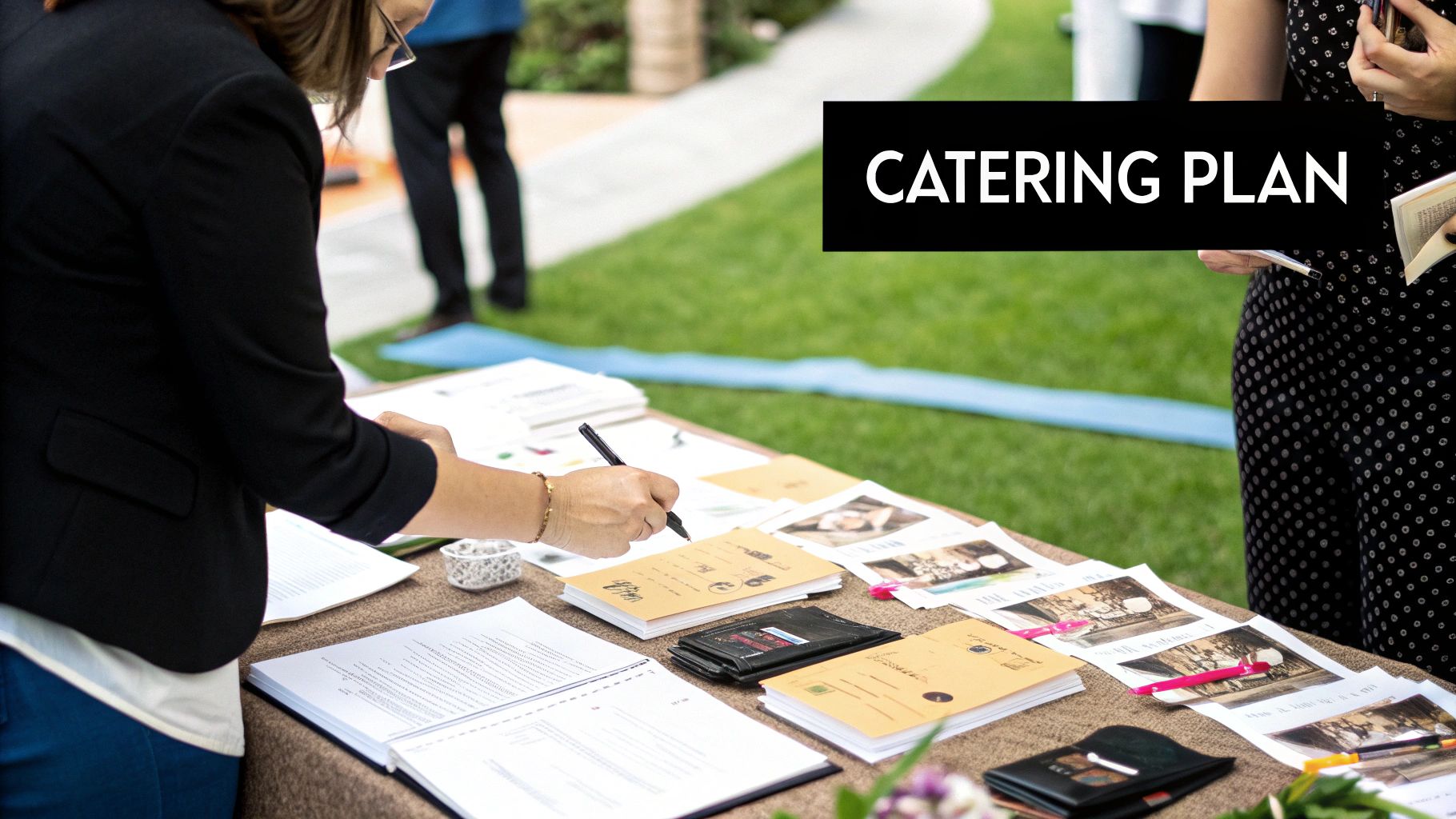
Before you even think about tasting menus, you need to lay some groundwork. This is where you define the core of your event. Getting these details sorted out upfront saves you from last-minute headaches and budget blowouts, paving the way for a smooth, successful day.
It's a huge part of the event industry for a reason. In the United States alone, the catering market was valued at USD 72.67 billion and is expected to climb to an impressive USD 132.62 billion by 2034. That growth shows just how vital professional catering has become for both corporate and social events.
To get started on the right foot, it helps to have a clear checklist.
Initial Catering Planning Checklist
This simple table breaks down the first few critical steps. Think of it as your starting line for making smart, informed decisions.
| Planning Element | Key Considerations | Pro Tip |
|---|---|---|
| Guest Count | Final RSVPs, potential walk-ins, and staff/vendor meals. | Always add a 5-10% buffer to your final number to avoid running short. |
| Budget | Per-person food cost, staffing, rentals, service fees, taxes, and gratuity. | Ask for an "all-in" quote that includes every potential charge to avoid surprises. |
| Event Style | Formal vs. casual, stationary vs. mingling, time of day. | Share a mood board or photos of similar events to give your caterer a clear visual guide. |
| Venue Logistics | Kitchen access, power, water, loading docks, and setup space. | Do a site visit with your caterer before signing a contract to spot any challenges early. |
With these basics covered, you can confidently move forward with finding the perfect catering partner.
Nailing Down Your Guest Count
The first number you absolutely need to lock down is your guest count. This single figure influences almost everything else—from how much food you’ll need to how many servers are on the floor.
Start with your confirmed RSVP list, but don’t stop there. I always recommend building in a small cushion. A 5-10% contingency on top of your final headcount is a smart move. It covers any surprise plus-ones or last-minute attendees, so you never have to worry about running out of food. It's always better to have a little extra than to have guests go home hungry.
Pro Tip: For events where attendance is less predictable, like a trade show or an open house, give your caterer a realistic range (e.g., "we're expecting 150-175 guests"). This gives them the flexibility to prep properly for a fluctuating crowd.
Crafting a Realistic Catering Budget
Your budget is so much more than a simple per-person cost. One of the most common mistakes I see is planners forgetting about all the other line items that make up the "all-in" price. A truly comprehensive budget protects you from sticker shock when the final bill comes.
Make sure your numbers account for these potential costs:
- Staffing: This isn't just servers. Think bartenders, chefs, and a catering manager. Labour can be a significant chunk of your total spend.
- Rentals: Do you need tables, chairs, linens, or glassware? What about serving equipment? These are often rented and billed separately.
- Service Fees and Gratuity: Most caterers add a service charge—usually 18-25%—to cover their operational costs. A tip for the staff might be on top of that.
- Taxes: Don't forget to factor in local and provincial taxes on the final total.
Getting this foundation right is a key part of organizing any successful event. For a comprehensive look at planning larger corporate functions, this ultimate corporate event planning checklist is an excellent resource.
Defining Your Event Atmosphere
Finally, what's the vibe you're going for? Is this a sophisticated, black-tie gala or a laid-back networking lunch? The atmosphere you want to create will guide everything from the menu to the style of service.
A formal wedding, for instance, naturally calls for an elegant, multi-course plated dinner. On the other hand, a casual corporate picnic is the perfect setting for a fun buffet or interactive food stations.
Be sure to communicate your vision clearly to any caterer you're considering. If you're hosting a high-energy product launch, you might want passed hors d'oeuvres and a lively cocktail setup to get people mingling. For a board meeting, you'll need something quiet and efficient that doesn't interrupt the conversation. Your event's tone is the brief your caterer uses to bring it all to life.
How to Find the Right Catering Partner
Finding the right caterer is about so much more than just good food. You're looking for a partner, someone who gets your vision and has the chops to pull it off without a hitch. It means going beyond a simple web search and really vetting who you're bringing on board.
First off, look for a specialist. A caterer who excels at small, elegant dinners probably isn’t the right call for a 500-person corporate blowout. Their online portfolios and photo galleries are your best friend here—spend some time looking at the kinds of events they typically handle. Does their style actually match what you need?
Gather Trusted Recommendations and Reviews
Your own network is often the best place to start. Ask your venue manager who they recommend. They've seen it all—the good, the bad, and the shockingly unprepared—so their preferred list is worth its weight in gold.
Once you have a few names, hit the online reviews, but read them with a critical eye. You're looking for more than just "the food was tasty." Pay close attention to comments about the less obvious stuff:
- Professionalism and Communication: Were they easy to get a hold of during planning? Did they respond quickly?
- Day-of Service: Did the team show up on time? How did they interact with guests?
- Problem-Solving: What happened when something went wrong? Did they handle a last-minute dietary request or a schedule change with grace?
These are the details that separate a good caterer from a great one and give you a real sense of what it's like to work with them.
Key Questions to Ask Potential Caterers
With a shortlist in hand, it's time to dig in with some pointed questions. The goal here is to confirm they have the specific experience your event demands. Don't be afraid to ask for proof.
A great starting question is whether they've worked at your venue before. Knowing the kitchen layout, the best place for load-in, and the house rules can prevent a world of logistical headaches on the day of the event. It’s also crucial to verify they can truly accommodate your guests' dietary needs, whether it's halal, kosher, vegan, or gluten-free. To see why this kind of expertise matters, check out the top reasons businesses choose a dedicated Toronto catering service for important events.
The Importance of the Tasting Session
Never, ever skip the tasting. This isn't just a chance to sample the menu; it's a dress rehearsal for the entire guest experience. Pay attention to everything—the presentation, the balance of flavours, and even the portion sizes.
A great tasting session should feel like a mini-event. It’s your best chance to see how a caterer performs under pressure, how they present their food, and how they respond to your feedback.
This is also your chance to get a feel for their team. Were they prepared? Did they listen to your thoughts and offer smart solutions? You want to build a good rapport and feel confident you can work closely with them.
When you're evaluating different caterers, keep a few key benchmarks in mind. This infographic breaks down what to look for.
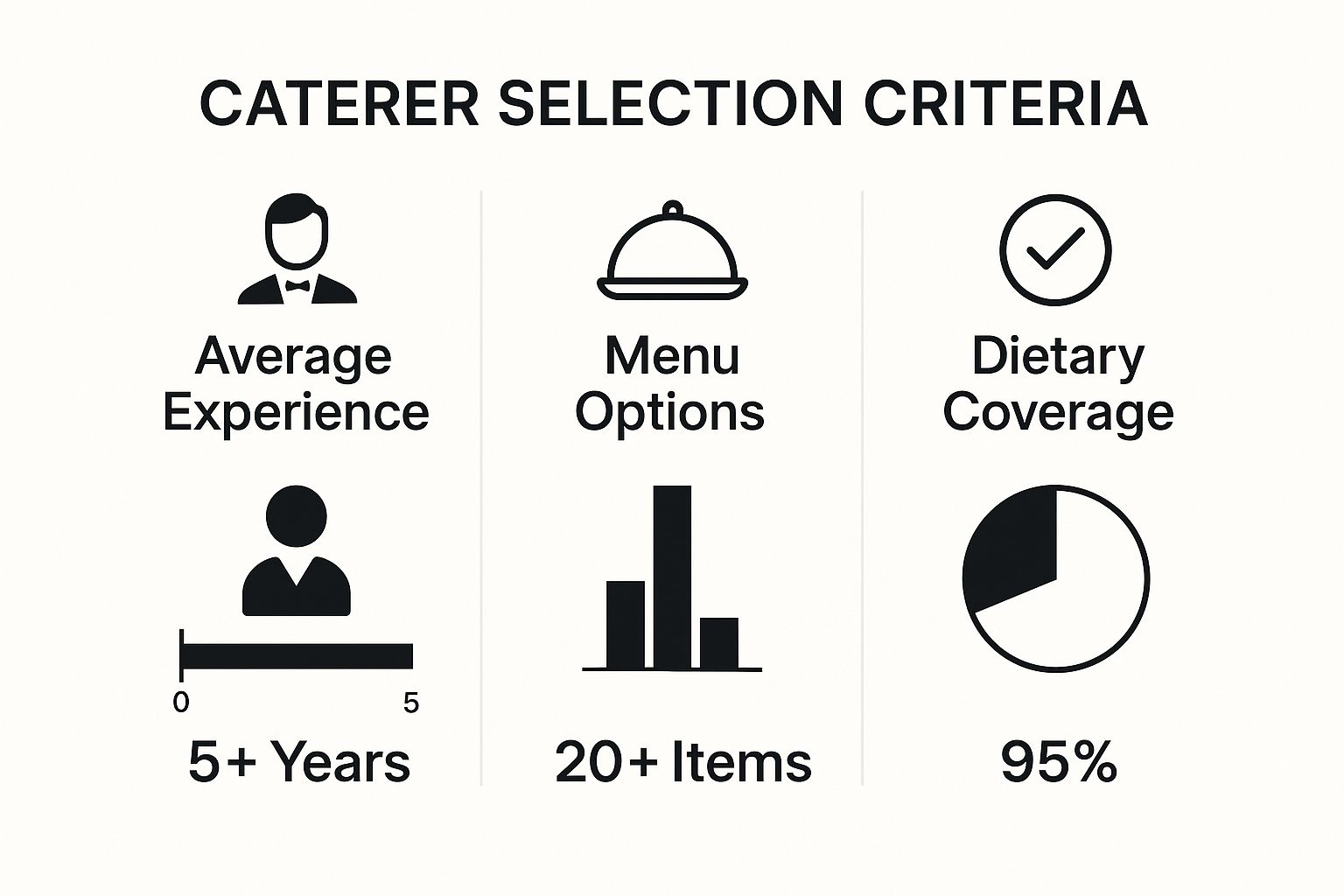
These numbers give you a solid baseline for a caterer's experience, flexibility, and ability to serve a diverse group, helping you make a much more informed decision.
Comparing Proposals and Making Your Choice
Once the tastings are done, the proposals will start rolling in. It’s incredibly tempting to just glance at the bottom-line price, but that can be a huge mistake. A cheaper quote might be hiding extra costs for staffing, rentals, or service fees that another caterer includes upfront.
I always recommend creating a simple spreadsheet to compare the proposals line by line. Make sure you’re truly comparing apples to apples. What's actually included? Look at everything from the number of staff hours to the quality of the linens.
The catering world is booming, with an annual revenue growth rate of about 10.9% in recent years. But that growth brings challenges like rising food and labour costs. Understanding exactly how each proposal breaks down these expenses is key to making a sound financial choice.
In the end, the right partner isn't just the one with a fair price. It's the one who gives you total confidence that they’ll deliver an incredible experience for you and your guests.
Designing Your Menu and Service Style
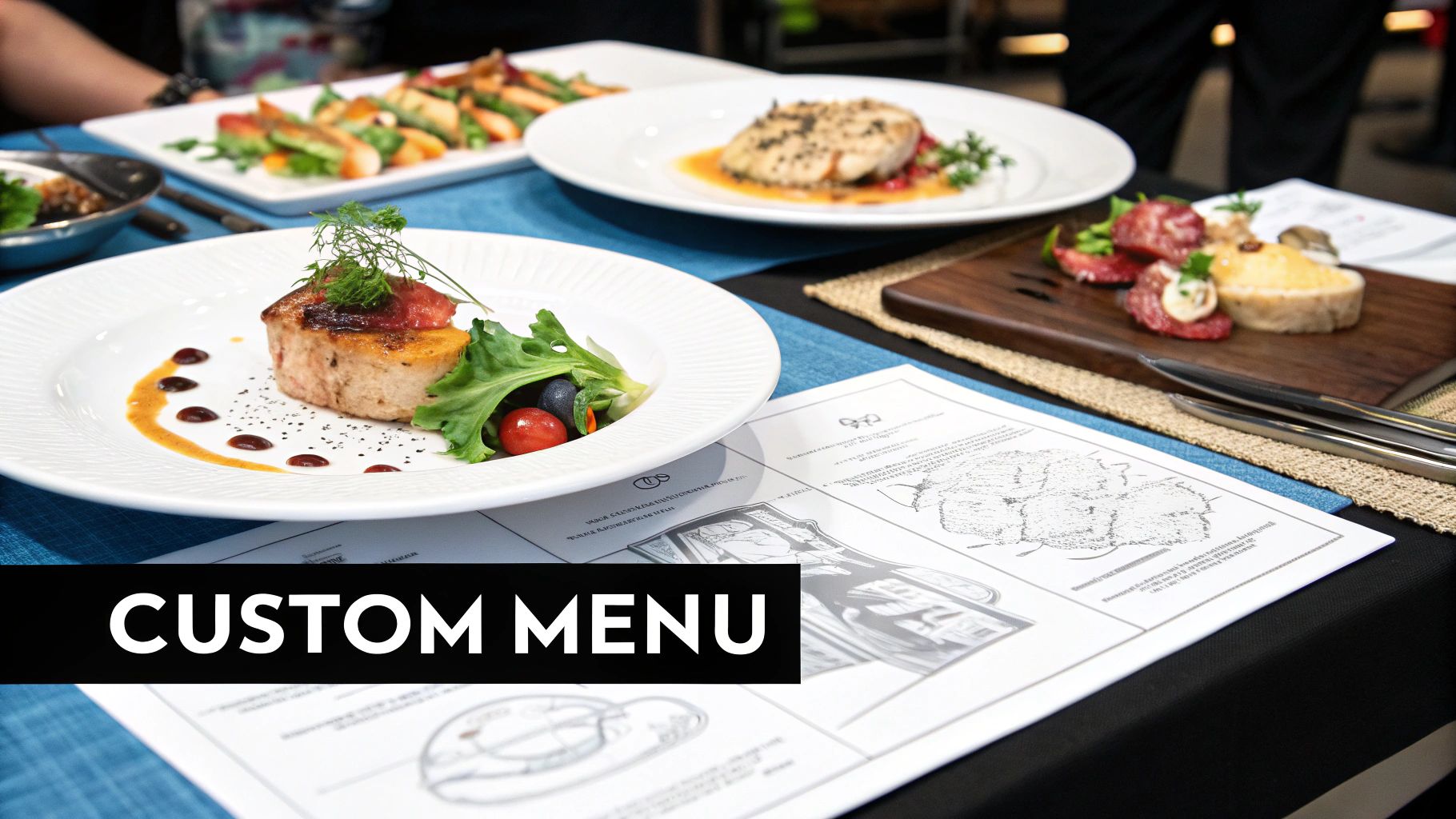
Let's talk about the heart of your event: the food. It’s what everyone remembers and what they’ll be talking about long after the lights go out. A truly memorable menu is so much more than a collection of tasty dishes; it’s a carefully crafted experience that reflects your event’s theme, timing, and overall vibe.
Think of the menu as part of your event's story. A rustic autumn wedding feels incomplete without seasonal touches like roasted root vegetables or spiced apple tarts. For a sleek tech launch, you’d want a menu that’s modern and clean—think artistic canapés and minimalist plating that scream innovation. The magic happens when the food feels like a natural, intentional part of the whole experience.
Aligning Food with Your Event Theme
First things first: your menu needs to sync up with your event's purpose. What kind of atmosphere are you trying to create? Is it a high-energy celebration or a more focused, professional gathering? The food should echo that mood.
A formal, sit-down meal would feel out of place at a casual networking mixer designed to get people talking. Here, passed hors d'oeuvres or interactive food stations are your best friends—they keep guests on their feet and mingling. On the other hand, a prestigious awards gala practically demands the elegance and structure of a plated dinner.
This push for highly personalized dining is a huge trend. The demand for bespoke menus that cater to specific themes and health-conscious guests has fuelled steady growth in the private chef and catering market. You can see the numbers for yourself in this market analysis.
Managing Dietary Requirements Effectively
Let’s be clear: handling dietary needs is no longer a "nice-to-have." It’s an essential part of catering for events. With food allergies and specific dietary preferences on the rise, a proactive approach is the only way to make sure every single guest feels safe and looked after.
The best way to tackle this is to get the information upfront. Your RSVP form is the perfect place. This gives your caterer plenty of time to get creative and source the right ingredients.
When you ask, be specific:
- Ask guests to clearly list any allergies (like nuts, shellfish, or gluten).
- Inquire about dietary preferences (vegetarian, vegan, halal, etc.).
- Always include an "other" field to catch anything you might have missed.
A truly professional caterer won't just default to a sad plate of steamed veggies. They’ll create thoughtful, delicious alternatives that are just as impressive as the main dishes, ensuring nobody feels like an afterthought.
Choosing the Right Service Style
How you serve the food dramatically shapes the flow and energy of your event. The big question is, what do you want your guests to do? Sit and focus, or get up and socialize?
Your service style dictates the guest experience. A buffet encourages movement and casual conversation, while a plated dinner creates a more formal, structured environment. Choose the style that best supports your event's primary objective.
Let's break down the most popular options.
Comparing Event Catering Service Styles
This table is a handy guide to the most common service styles, helping you see at a glance which one might be the best fit for your event.
| Service Style | Best For | Pros | Cons |
|---|---|---|---|
| Plated Dinner | Formal events like weddings, galas, and awards ceremonies. | Elegant, controlled portions, predictable timeline. | Less variety for guests, can be slower, requires more staff. |
| Buffet Style | Casual to semi-formal events, corporate lunches, large gatherings. | Lots of variety, encourages mingling, cost-effective for large groups. | Can create long lines, potential for food waste, less formal feel. |
| Food Stations | Interactive and themed events, cocktail receptions, networking mixers. | Fun and engaging, breaks up crowds, allows for diverse cuisines. | Can require more space, may increase staffing needs per station. |
| Family Style | Communal and intimate gatherings, rehearsal dinners, relaxed weddings. | Encourages interaction, feels warm and social, offers variety. | Can be messy, takes up significant table space, portioning can be uneven. |
Each style has its moment to shine. For instance, a well-organized buffet-style office catering menu can be the perfect solution for a corporate lunch where you need both variety and efficiency. It lets everyone pick their favourites while keeping the event on schedule. At the end of the day, the right choice is the one that flawlessly matches your vision and makes the experience better for your guests.
Nailing Down the Details: Contracts and Day-Of Logistics
You’ve found your perfect caterer and the menu is set. Fantastic! Now comes the part that isn't as glamorous but is absolutely critical: locking it all in with a solid contract and a detailed game plan. This is where you move from tasty ideas to a concrete, executable event. Honestly, a well-defined contract and a clear timeline are your best defense against last-minute chaos.
Think of the contract as your event’s playbook. It’s not just a formality; it’s a binding agreement that protects both you and the caterer. It lays out every responsibility, expectation, and what-if scenario. My number one rule? Never, ever sign a contract without reading every single word. The fine print is where the important stuff lives.
What to Look for in Your Catering Contract
A good catering contract should leave zero room for interpretation. It’s a roadmap that spells out exactly what you're getting and what the caterer is bringing to the table. Before you put pen to paper, scan the document for a few non-negotiable elements.
First, check for an itemized cost breakdown. You should see clear, separate lines for food, drinks, staffing (how many people and what they'll be doing), rentals, and any service or admin fees. This transparency is key to understanding the real cost and avoiding surprise charges on the final bill.
Beyond the numbers, you'll want to pay close attention to these clauses:
- Payment Schedule: Know exactly what the deposit is and when the final balance is due.
- Cancellation Policy: What happens if you have to cancel or postpone? Understand the financial hit—what's non-refundable and by what date.
- Liability Insurance: Your caterer absolutely needs to have adequate liability insurance. Most venues won't even let them in the door without proof.
- Final Guest Count Deadline: There will be a hard deadline for giving your final headcount. After this date, you can usually add guests, but you can’t subtract them from the bill.
A clear contract is the foundation of a great partnership. It ensures everyone is on the same page from the start, which is essential when you're coordinating all the moving parts of catering for events.
Getting Your Venue and Vendors on the Same Page
Here’s a pro tip: your caterer doesn't work in a bubble. They're a key player on a team that includes your venue manager, DJ, florist, and everyone else you’ve hired. When all these moving parts work in sync, that’s when the real magic happens.
The very first thing to do is connect your catering manager with the venue coordinator. They need to talk logistics. We're talking about the real nitty-gritty stuff, like kitchen access. Is it a full-service kitchen, or will the caterer need to set up a field kitchen? They also need to sort out power, water access, and where they can set up and break down without getting in anyone’s way.
For corporate events, looking into comprehensive catering packages can make this whole process much simpler by bundling services and having these logistics pre-planned.
Making these connections early prevents day-of disasters—like the DJ setting up their booth right where the buffet line is supposed to go, or the caterer tripping a breaker because they didn't have enough power for their warming ovens.
Your Secret Weapon: The Day-Of Timeline
Finally, it’s time to create the master timeline. This document is the single source of truth for your entire event day, mapping out everything from the first arrival to the final cleanup. Don't be vague; get granular.
This timeline should list specific arrival times for every vendor, not just the caterer. It also needs to chart the key moments for food and beverage service.
Here’s what a timeline for an evening event might look like:
- 2:00 PM: Catering team arrives for load-in and begins setting up.
- 4:00 PM: All tables, linens, and place settings are in position.
- 5:30 PM: Bar staff starts prepping for cocktail hour; kitchen is in final prep mode.
- 6:00 PM: Guests arrive; appetizer service kicks off.
- 7:15 PM: Guests are invited to take their seats for dinner.
- 7:30 PM: The first course hits the tables.
- 9:00 PM: Dessert and coffee are served.
- 11:00 PM: Last call at the bar.
- 11:30 PM: Catering breakdown and cleanup begins.
Send this timeline out to all your key vendors at least a week ahead of time. A shared, detailed plan means everyone knows their part, which lets you step back, relax, and actually enjoy the event you worked so hard to create.
Making Sure the Big Day Goes Off Without a Hitch
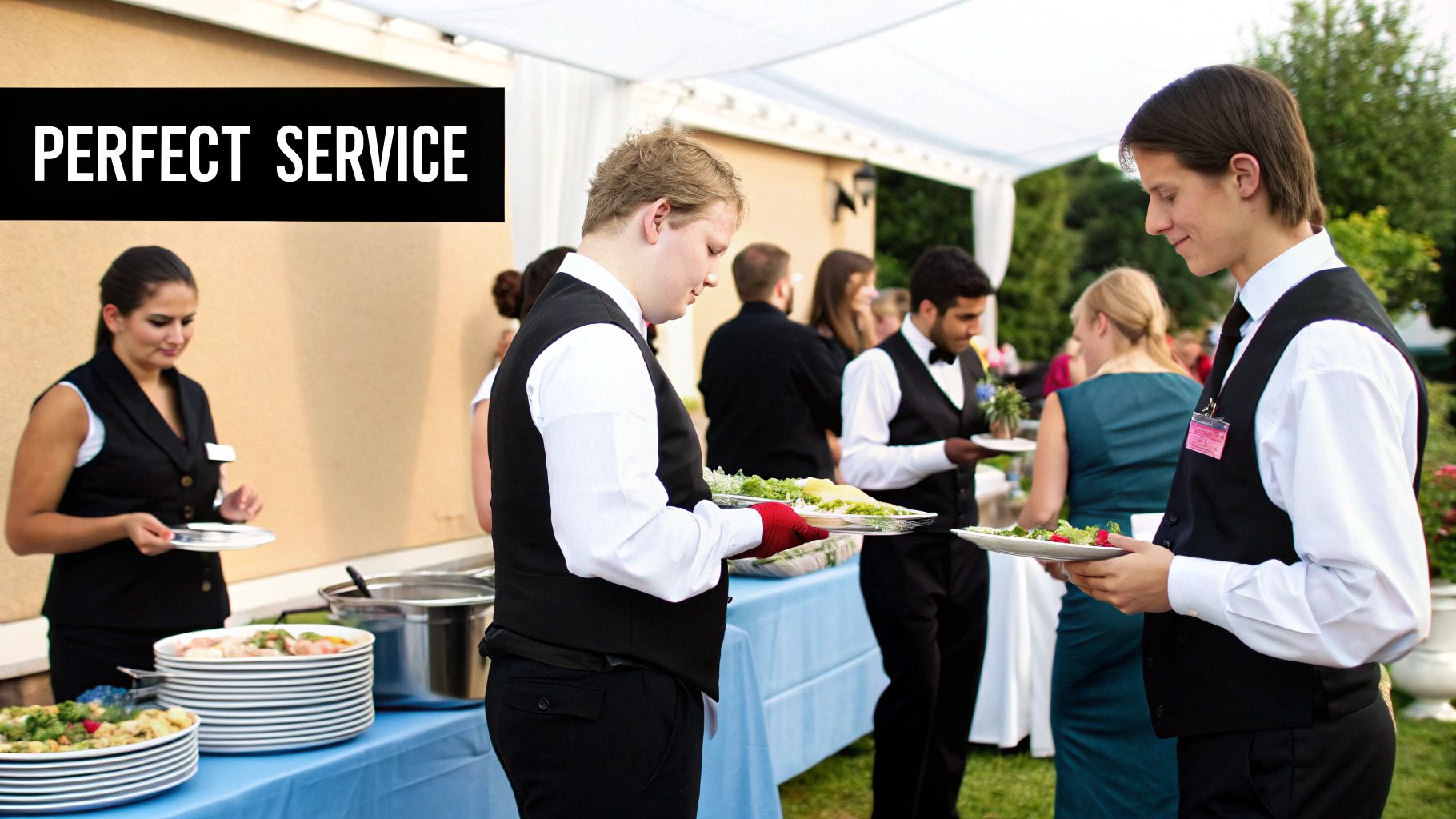
After all the planning, the day of your event is the real test. This is where every choice you've made—from the menu to the floor plan—comes to life. The focus shifts from planning to pure execution, and the goal is to deliver a service experience that’s just as impressive as the food itself.
A truly successful event day boils down to two things: seamless execution and the ability to solve problems on the fly. You need the catering team to operate like a well-oiled machine, effortlessly adapting to the event’s rhythm while providing incredible service from start to finish.
The Final Pre-Event Huddle
About a week out, get on a final call with your catering manager. This isn't just a quick "all good?" check-in; it's a detailed walkthrough to make sure you're both on the exact same page. This meeting is your last, best chance to catch any small misunderstandings before they can become big problems on the day.
Here's what to nail down in that huddle:
- Confirm the final timeline: Go through the entire schedule, minute by minute. Start from when the catering truck arrives for load-in and go all the way to when the last piece of equipment is packed away.
- Review last-minute changes: This is the time to lock in any final tweaks to the guest count, dietary requests, or the event flow.
- Verify contact information: Double-check that you have the mobile number for the on-site catering lead and that they have yours. You need a direct line.
This final touchpoint builds a ton of confidence and reinforces that you're a team, setting the stage for a smooth, collaborative event day.
Designate a Single On-Site Contact
On event day, everything moves a mile a minute. To cut through the potential chaos, you absolutely must establish one primary point of contact for anything and everything related to catering. This person—whether it's you, your event coordinator, or a trusted colleague—becomes the sole liaison between your organization and the catering manager.
Think of this person as your secret weapon for handling the unexpected. Let's say a few extra guests show up unannounced. Instead of multiple people rushing over to the catering staff and causing a panic, your designated contact can quietly pull the catering lead aside, explain the situation, and figure out a solution without anyone else even noticing.
This streamlined communication keeps everything calm and allows for quick, decisive action when you need it most.
A single, empowered point of contact is the command centre of your event day. It ensures clear communication, prevents conflicting instructions, and allows your catering team to respond to challenges quickly and professionally.
Mastering the Post-Event Wrap-Up
Just because the last guest has walked out the door doesn't mean the work is done. A professional wrap-up is just as crucial as the event itself. It ensures a clean venue, settles all the financials, and builds a great relationship with your caterer for the future. While any good catering team has their breakdown process down pat, you need to coordinate the details with them.
Get clear on who is responsible for what. Does the caterer handle all the rubbish removal, or do they need to take it to a specific venue dumpster? Who’s in charge of packing up any leftover food? Sorting these details out beforehand saves you from any post-event headaches or finger-pointing.
Handling Payments and Providing Feedback
Your contract should spell out the payment schedule, but it's always smart to confirm the details of the final invoice. Give it a thorough review to make sure it lines up perfectly with the services and guest count you agreed on. Paying that final bill promptly is a sign of professionalism that caterers really appreciate—and remember.
Once the finances are settled, take a few minutes to give some thoughtful feedback. A great caterer genuinely wants to know what they knocked out of the park and where they could do even better. Did guests rave about a particular dish? Was the service staff incredibly attentive? Share those wins.
If there were any hiccups, bring them up constructively. This kind of feedback is invaluable for them and helps them sharpen their service for the next client. This respectful, two-way communication is how you build a real partnership, making future catering for events even more successful.
Remember, great food is only one part of the equation. It's worth looking into effective audience engagement strategies for events to complement the catering and elevate the entire experience. When you pair fantastic food with thoughtful guest interaction, you create something truly memorable.
Answering Your Top Event Catering Questions
Even the most seasoned event planner has questions pop up when coordinating catering. It's completely normal. Getting those nagging uncertainties cleared up early on saves a world of stress and helps you move forward with confidence. Let's walk through some of the most common questions I hear from clients.
So, when should you actually book your caterer? The honest answer is: it depends. For a big, milestone event like a wedding or a large-scale gala, you'll want to lock in your caterer 9-12 months in advance. The really great ones book up fast, especially if you have your heart set on a specific team.
For smaller corporate lunches or meetings, you have a bit more breathing room—3-6 months is a safe bet. But here's a key piece of advice: if your event is during a peak month like June or December, book as early as you possibly can. Don't risk your first-choice caterer being unavailable.
What’s the Deal with Gratuity?
Tipping is always a tricky subject, isn't it? Some caterers build a service charge or gratuity right into their quote, while others leave it to your discretion. The most important thing you can do is ask about it when you're reviewing the contract. No surprises later.
If it's not included, the industry standard is around 15-20% of the total food and beverage cost. Alternatively, some people prefer to tip the staff directly. A good rule of thumb for this approach is:
- $20-$50 for each server and bartender
- $100-$200 for the head chef or catering manager
It's a wonderful way to acknowledge the team's hard work behind the scenes.
Pro Tip: Just ask your catering manager what their policy is. They'll give you the straight scoop on what's customary for their crew, making sure your gesture of thanks is handled perfectly.
How Do I Make Sure There's Enough Food?
The fear of running out of food is real for every host. While your caterer is a pro at this, it helps to know the basics. For a main meal, like a dinner buffet, a safe estimate is about one pound of food per adult.
Things change when you're just serving appetizers. If it's a two-hour cocktail party before dinner, aim for 8-12 bites per person. But if those appetizers are the meal? You'll need to bump that up to 12-15 pieces per guest to keep everyone happy. Your caterer will fine-tune these numbers based on your specific menu and the flow of your event, so lean on their expertise.
Who Handles the Cleanup?
This is a detail you absolutely want to clarify beforehand. A full-service caterer will typically clear all the plates and glasses, manage the waste from the food service, and leave any kitchen or prep space they used spotless.
What they don't usually do is break down tables and chairs, sweep the entire venue, or take down your decorations. Those tasks usually fall to the venue staff or a rental company. A quick conversation to confirm who-does-what in the contract will prevent any last-minute scrambling after your guests have gone home. It's all about ensuring a smooth finish to a great event.
At Shawarma Moose, we believe catering for events should be straightforward and delicious. We're here to answer every question and deliver authentic Middle Eastern cuisine that your team will love. As your go-to partner for corporate and office catering in Toronto, we handle the details so you don't have to. Explore our customizable catering options and get a stress-free quote today.
